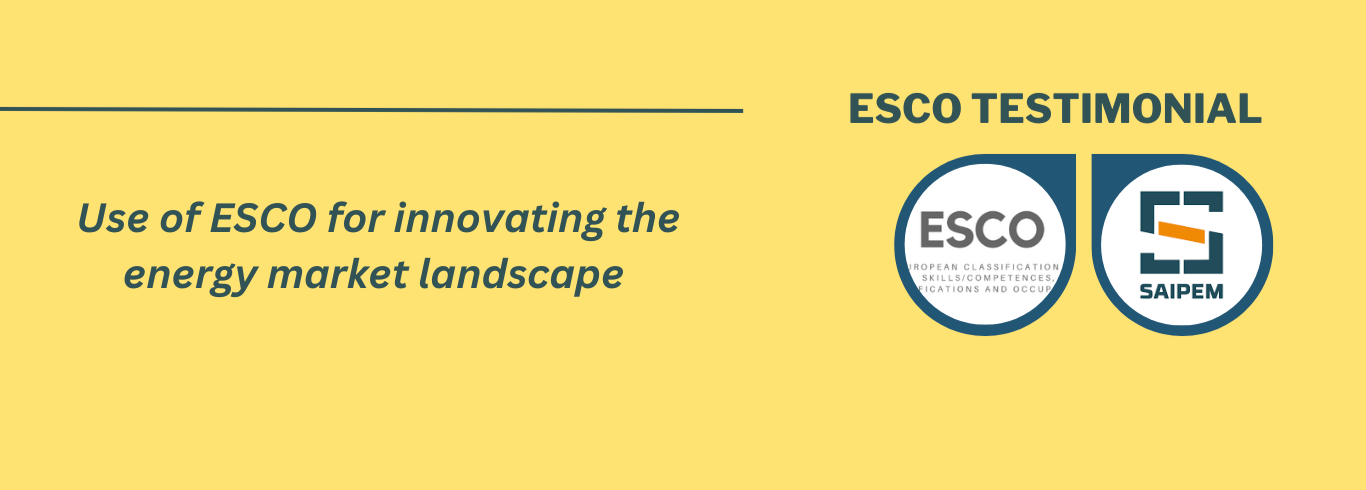Saipem using ESCO for innovating the energy market landscape
ESCO testimonials

The following testimonial is part of a series of interviews conducted by the ESCO Secretariat with ESCO implementers. Their purpose is to shed light on ESCO strengths and challenges as perceived by implementers so that current and potential future stakeholders can gain better knowledge on the use of ESCO. In this testimonial, we discuss how Saipem is implementing ESCO in the energy and infrastructure sector.
Tell us a bit more about your project/company/organisation, your goal, target customers, how many clients/users you currently have, geographical coverage, etc.
Saipem is a global leader in the engineering and construction of major projects for the energy and infrastructure sectors, both offshore and onshore. Our purpose is “engineering for a sustainable future” and we are committed to supporting our clients on the energy transition pathway towards Net Zero, with increasingly digital means, technologies, and processes geared for environmental sustainability. We are present in more than 50 countries and employ about 30,000 people of over 130 nationalities.
How do you leverage ESCO in your services, and since when are you using it?
Saipem proposed the use of the ESCO taxonomy at the end of 2023 during the work of a national energy sector association’s task force which aimed to define a plan for the development of the skills required by the energy market, with a specific focus on those needed for transition technologies.
The common language of ESCO allowed partners to match the skills and occupations specific to each technology which were previously mapped through interviews with our Technology Managers with those present in ESCO, thus overcoming the differences between the various proprietary taxonomies. Furthermore, leveraging the open data made available annually by the Italian Ministry of University and Research, ESCO also allowed us to enrich the analysis with the mapping of specific courses addressing the skills needed for the energy transition. The result is a dashboard that can be searched by each technology that is part of the Italian strategic scenario of the energy transition.
Potentially this mapping could be further enriched with data from other EU universities, by using the International Standard Classification of Education code. With the same approach, we have developed an internal dashboard which we currently leverage for our recruitment plan and for our employer branding initiatives within our academic network.
What were some of the challenges you encountered in implementing ESCO?
In the effort to align our approximately 600+ professional roles and 600+ technical-executive skills, consolidated in almost 70 years of presence on the global market, we identified areas where ESCO could be further expanded and enriched to include new occupations like Fabrication methods engineer, and skills relevant for our industry like specific ones connected to Carbon Capture Utilization and Storage technology. We are now taking advantage of the services that ESCO makes available to support the mapping of our taxonomy and based on the results we will be able to propose the inclusion of new occupations and skills.
What is the key ingredient in ESCO that made you take the decision to use it in your system?
The key ingredient that influenced our decision to explore ESCO taxonomy usage is its ability to enable new collaboration models and reskilling/upskilling synergies among value-chain players. ESCO's interoperability enhances educational institutions to develop targeted programs, facilitates labour mobility at a transnational level, provides a framework for trends anticipation and dynamic update of the skills required in response to rapid technological changes and new regulations.
What was the level of acceptance by your partners/other national stakeholders?
The players of the task force where we developed the first concept have expressed significant interest in the use-case we have implemented, so we are thinking of proposing this approach to our customers as well. We would also like to align system-wide efforts and build an educational and occupational ecosystem for the benefit not only of our company, but of the entire energy sector, also given the crosswalk between ESCO and the standard US taxonomy, O*Net. Ultimately, we strive to advance a positive social impact through a data-driven tool useful for industrial, occupational, educational and migration strategies.
What are some of your recommendations for other stakeholders looking to implement ESCO in their system?
The speed at which energy sector technologies are advancing requires companies and employees to adapt quickly to remain competitive and respond effectively to the dynamic challenges of the sector, which is experiencing a significant shortage and mismatch of the skills needed to support both the conventional market and the transition to renewable energy and new technologies. Our recommendation is to test the taxonomy and evaluate if it could be useful as well for your business strategy.
How has ESCO helped your business/organisation? What are its advantages and disadvantages from your standpoint?
The dashboard applied to Saipem's training needs and hiring plan has allowed us to define a bridge with the universities of interest, contributing through partnership to the reduction of the shortage and mismatch between demand and supply of skills, supporting the growth of skills in a specific territory. Some examples are shown in the screenshots below.


